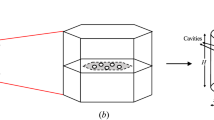Abstract
Welded components of CrMoV steam pipe exhibit a pernicious form of type IV cracking after long-term service at elevated temperature. To investigate the cracking mechanism, the type IV microstructure and hardness were characterized after thermal simulation of post-weld heat treatment. Below 1098 K (825 °C), loss of carbon from the pearlite region was apparent, and the work zone exhibited a slightly lower hardness than the parent material because of a minor amount of austenite transformation. In addition, for peak temperatures above 1133 K (860 °C), additional transformation into austenite occurred and was followed by retransformation into ferrite upon further increasing the temperature. The pearlite formed at 1173 K to 1223 K (900 °C to 950 °C) resulted in an increase of the volume fraction of pearlite and microstructural refinement, which yielded a remarkable increase of hardness in the work zone. For the peak temperature of 1573 K (1300 °C), previous austenite grains were coarsened and alloy carbides were dissolved in the austenite, which significantly hardened the work zone.










Similar content being viewed by others
Abbreviations
- Ac1:
-
Start of transformation on heating
- Ac3:
-
Finish of transformation on heating
- TS:
-
Start of transformation on cooling
- TF:
-
Finish of transformation on cooling
- TRANGE:
-
Temperature range of rapid transformation
- TP:
-
Peak temperature
- CT:
-
Cooling time [from TP to 773 K (500 °C)]
- HR:
-
Heating rate, temperature range 573 K to 973 K (300 °C to 700 °C)
- T1:
-
Start of high-temperature transformation on cooling
- T2:
-
Finish of high-temperature transformation on cooling
- TM:
-
Temperature of maximum transformation rate
- PWHT:
-
Post-weld heat treatment
References
Bhadeshia HKDH (2001) ISIJ Int, 41:626-640
W. Sun, T.H. Hyde, A.A. Becker, and J.A. Williams: International Journal of Pressure Vessels and Piping, 2000, vol. 77, pp. 389-398.
T.H. Hyde, W. Sun, A.A Becker, and J.A. Williams: International Journal of Pressure Vessels and Piping, 2001, vol. 78, pp. 365-372.
T.H. Hyde, W. Sun, and A.A. Becker: International Journal of Pressure Vessels and Piping, 2001, vol. 78, pp. 765-771.
Hayhurst R J, Mustata R, and Hayhurst D R: International Journal of Pressure Vessels and Piping, 2005, vol. 82, pp. 137-144.
Zieliński A, Dobrzański J, and Krztoń H: Journal of Achievements in Materials & Manufacturing Engineering, 2007, vol. 25, pp. 33-36.
Dobrzański J, Zieliński A, and Krztoń H: Journal of Achievements in Materials & Manufacturing Engineering, 2007, vol. 23, pp. 39-42
M.E. Abd El-Azim, M.E. Nasreldin, G. Zies, and A. Klenk: Mater. Sci. Technol, 2005, vol. 21, pp. 779-1063.
T. H. Hyde, M. Saber, and W. Sun: Int. J. Press. Vessels Pip, 2010, vol. 87, pp. 721-729.
K. Sawada, H. Kushima, K. Kimura, and M. Transactions of the Indian Institute of Metals, 2010, vol. 63, pp. 117-122
Lei Zhao, Hongyang Jing, Lianyong Xu, Junchao An, Guangchun Xiao, Delu Xu, Yucheng Chen, and Yu Han: Journal of Materials Research, 2011, vol. 26, pp. 934-943.
M. Divya, C. R. Das, S. K. Albert, Sunil. Goyal, P. Ganesh, R. Kaul, J. Swaminathan, B. S. Murty, L. M. Kukreja, and A.K. Bhaduri: Materials Science and Engineering: A, 2014, vol. 613, pp. 148-158.
D J. Abson and J S. Rothwell: International Materials Reviews, 2013, vol. 58, pp. 437-473.
K. LAHA, K.S. CHANDRAVTHI, P. PARAMESWARAN, K. RAO, and S.L. MANNAN: Metallurgical and Materials Transactions A, 2007, vol. 38, pp. 58-68.
Goyal S, Laha K, Chandravathi KS, Parameswaran P, Mathew MD (2011) Philos. Mag. 91:3128-3154.
T. Sakthivel, K. Laha, M. Vasudevan, M. Koteswara Rao, and S.Panneer Selvi: Materials at High Temperatures, 2016, vol. 33, pp. 137-153.
P. Mohyla, P. Tomèík, L. Beneš, and I. Hlavaty: Metal Science & Heat Treatment, 2011, vol. 53, pp. 374-378.
Acknowledgments
One of the authors (Bin Xu) wishes to acknowledge Professor Jitai Niu for his exceeding support and encouragement to collaborate on CrMoV thermal simulation studies. All authors would like to acknowledge the support by Doctoral Funds from Southwest University of Science and Technology (13zx7153, 10zx7143). We thank Tiffany Jain, M.S., from Liwen Bianji, Edanz Group China (www.liwenbianji.cn/ac), for editing the English text of this manuscript.
Author information
Authors and Affiliations
Corresponding author
Additional information
Manuscript submitted November 14, 2016.
Rights and permissions
About this article
Cite this article
Xu, B., Xue, S., Cai, Y. et al. Thermal Simulation Analysis of Microstructure and Hardness for CrMoV with PWHT in Type IV Region. Metall Mater Trans B 48, 2813–2819 (2017). https://doi.org/10.1007/s11663-017-1084-8
Received:
Published:
Issue Date:
DOI: https://doi.org/10.1007/s11663-017-1084-8




